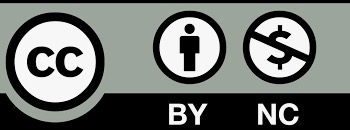Published
2024-03-22
Issue
Section
Research Articles
License
The journal adopts the Attribution-NonCommercial 4.0 International (CC BY-NC 4.0), which means that anyone can reuse and redistribute the materials for non-commercial purposes as long as you follow the license terms and the original source is properly cited.
Author(s) shall retain the copyright of their work and grant the Journal/Publisher rights for the first publication with the work concurrently licensed since 2023 Vol.8 No.2.
Under this license, author(s) will allow third parties to download, reuse, reprint, modify, distribute and/or copy the content under the condition that the authors are given credit. No permission is required from the authors or the publisher.
This broad license intends to facilitate free access, as well as the unrestricted use of original works of all types. This ensures that the published work is freely and openly available in perpetuity.
By providing open access, the following benefits are brought about:
- Higher Visibility, Availability and Citations-free and unlimited accessibility of the publication over the internet without any restrictions increases citation of the article.
- Ease of search-publications are easily searchable in search engines and indexing databases.
- Rapid Publication – accepted papers are immediately published online.
- Available for free download immediately after publication at https://esp.as-pub.com/index.php/ESP

Copyright Statement
1.The authors certify that the submitted manuscripts are original works, do not infringe the rights of others, are free from academic misconduct and confidentiality issues, and that there are no disputes over the authorship scheme of the collaborative articles. In case of infringement, academic misconduct and confidentiality issues, as well as disputes over the authorship scheme, all responsibilities will be borne by the authors.
2. The author agrees to grant the Editorial Office of Environment and Social Psychology a licence to use the reproduction right, distribution right, information network dissemination right, performance right, translation right, and compilation right of the submitted manuscript, including the work as a whole, as well as the diagrams, tables, abstracts, and any other parts that can be extracted from the work and used in accordance with the characteristics of the journal. The Editorial Board of Environment and Social Psychology has the right to use and sub-licence the above mentioned works for wide dissemination in print, electronic and online versions, and, in accordance with the characteristics of the periodical, for the period of legal protection of the property right of the copyright in the work, and for the territorial scope of the work throughout the world.
3. The authors are entitled to the copyright of their works under the relevant laws of Singapore, provided that they do not exercise their rights in a manner prejudicial to the interests of the Journal.
About Licence
Environment and Social Psychology is an open access journal and all published work is available under the Creative Commons Licence, Authors shall retain copyright of their work and grant the journal/publisher the right of first publication, and their work shall be licensed under the Attribution-NonCommercial 4.0 International (CC BY-NC 4.0).
Under this licence, the author grants permission to third parties to download, reuse, reprint, modify, distribute and/or copy the content with attribution to the author. No permission from the author or publisher is required.
This broad licence is intended to facilitate free access to and unrestricted use of original works of all kinds. This ensures that published works remain free and accessible in perpetuity. Submitted manuscripts, once accepted, are immediately available to the public and permanently accessible free of charge on the journal’s official website (https://esp.as-pub.com/index.php/ESP). Allowing users to read, download, copy, print, search for or link to the full text of the article, or use it for other legal purposes. However, the use of the work must retain the author's signature, be limited to non-commercial purposes, and not be interpretative.
Click to download <Agreement on the Licence for the Use of Copyright on Environmental and Social Psychology>.
How to Cite
Identifying distinctions in the perception of fast food and sport shoes brands by children and adolescents based on the brand meaning model
Marina Tsoy
Marketing and Service Department, Novosibirsk State Technical University
Vladislav Shchekoldin
Marketing and Service Department, Novosibirsk State Technical University
DOI: https://doi.org/10.54517/esp.v9i6.2428
Keywords: brand, perception, brand meaning, children marketing, Saaty's method
Abstract
The article makes an effort to evaluate the influence of a brand meaning on the perception of popular products by children and adolescents on the example of junk food and sport shoes. The study involved 703 pupils of secondary schools from 11 to 18 years old. The proposed approach is based on the use of the Saaty's method, which allows to assess the influence of different factors on the perception of brands by children and adolescents and to determine the distinctions in their perception of brands of various types of products. Based on the analysis, a hierarchical structure of brand perception by children was built. It includes the brand awareness, brand logo recognition, consumer impression of brand advertising. The weighting coefficients of the hierarchical model for fast food and sport shoe brands were estimated and the results were compared, distinctions and similarities were identified in the perception of brands of various types of goods by children and adolescents. For fast food brands, perception of brand quality plays a major role, whilst for sport shoe the brand attractiveness is the most important factor.
References
[1]. Aaker D. Managing Brand Equity: Capitalizing on the Value of a Brand Name. New York, Free Press, 1991.
[2]. Armstrong G., Kotler P. Marketing: An Introduction. New Jersey. Pearson Education Inc., Upper Saddle River, 2005.
[3]. Batey M. Brand meaning. Taylor & Fransis Group, New York: Routledge, 2008.
[4]. Effertz T., Teichert T., Tsoy M. Fast food, ads, and taste in a Russian child’s mind. Psychology & Marketing, 2019, 36 (3): 175-187. doi: 10.1002/mar.21171.
[5]. Feltham T. Judgment of ads viewer judgment of ads: the persuasive disclosure inventory, in Bearden, W.O. and Netemeyer, R. G. (Ed.), Handbook of marketing scales: Multi-item measures for marketing and consumer behavior research. 2nd ed., Newbury Park, CA: Sage Publication, 1999.
[6]. Fetscherin M., Heilmann T. Consumer Brand Relationships Meaning, Measuring, Managing. New York: Palgrave Macmillan Book, 2015.
[7]. Griffin M., Lahman M., Opitz M. Shoulder-to-shoulder research with children: Methodological and ethical considerations. Journal of Early Childhood Research, 2016, 14(1): 18–27. https://doi.org/10.1177/1476718X14523747.
[8]. Hayes J., Alford B., Silver L., York R. Looks Matter in Developing Consumer-Brand Relationships. Journal of Product and Brand Management, 2006, 15 (5): 306-315. doi: 10.1108/10610420610685875.
[9]. Hughes A. Brand, branding and brand culture among young consumers. In A. Gbadamosi (Ed.), Young consumer behaviour (119–137). London: Taylor and Francis, 2018.
[10]. Keller K. Conceptualizing, Measuring, Managing Customer Based Brand Equity. Journal of Marketing, 1993, 57(1): 1-22. https://doi.org/10.1177/ 002224299305700101.
[11]. Kovacs L., Lenart I., Endrody O. Brand names in the mind of Hungarian, Russian, and Laotian kindergarten children: Evidence from word association experiments. Hungarian Educational Research Journal, 2021, 11(4): 413–425. doi: 10.1556/ 063.2021.00072.
[12]. McNeal J. Kids as Consumers: A Handbook of Marketing to Children. New York: Lexington Books, 1992.
[13]. Roberto C., Baik J., Harris J., Brownell K. Influence of Licensed Characters on Children's Taste and Snack Preferences. Pediatrics; 2010, 126 (1): 88-93. doi: 10.1542/peds.2009-3433.
[14]. Robinson T., Borzekowski D., Matheson D., Kraeme H. Effects of Fast Food Branding on Young Children’s Taste Preferences. Arch Pediatric Adolescent Med, 2007, 8: 792-797. doi: 10.1001/archpedi.161.8.792.
[15]. Shchekoldin V., Timofeev V., Faddeenkov A. Econometrics. 2nd ed. URAIT, Moscow, 2015.
[16]. Saaty T. The Analytic Hierarchy Process. New York: McGraw Hill International, 1980.
[17]. Shchekoldin V. Y., Tsoi M. E. Perception and evaluation of brand meaning among children and adolescents. In: Proceedings of the international science conference “Marketing management, trade, financial and social aspects of business”; 20–21 October 2016, Kosice, Slovak Republic, Kosice,: pp. 204-212.
[18]. Smit, C. R., Buijs, L., van Woudenberg, T. J., et al. The Impact of Social Media Influencers on Children’s Dietary Behaviors. Frontiers in Psychology, 2020, 10: 1-6. https://doi.org/10.3389/fpsyg.2019.02975.
[19]. Smith S.M., Albaum G.S. Basic Marketing Research, Volume 1 (Handbook for Research Profesionals), Provo: Qualtrics Labs Inc, 2012.
[20]. Teichert T., Effertz T., Tsoi M., Shchekoldin V. Predicting brand perception for fast food market entry. Theoretical Economics Letters. 2015, 5(6): 697-712. doi: 10.4236/tel.2015.56081.
[21]. Tsoi M., Shchekoldin V. Assessment of family members influence on the purchase decision-making process. In: Proceedings of the International multidisciplinary scientific conference on social sciences and arts (SGEM2014); 3–9 September 2014: Albena, Bulgaria. Book 2, vol. 3. – рр. 65-74.
[22]. Wang F., Li Sh. When does product brand matter to children? International Journal of Market Research, 2019, 61(4): 380–393.
[23]. Weigold, M.F., Flusser, S., Ferguson, M.A. Direct Response Advertising: The Contributions of Price, Information, Artwork, and Individual Differences to Purchase Consideration. Journal of Direct Marketing, 1992, 6(2): 32-39.
[24]. Young B., Claessen M. Children and advertising: Research study – children’s categorization of food. London: The Food Advertising Unit, The Advertising Association, 1998.







